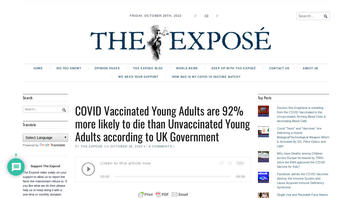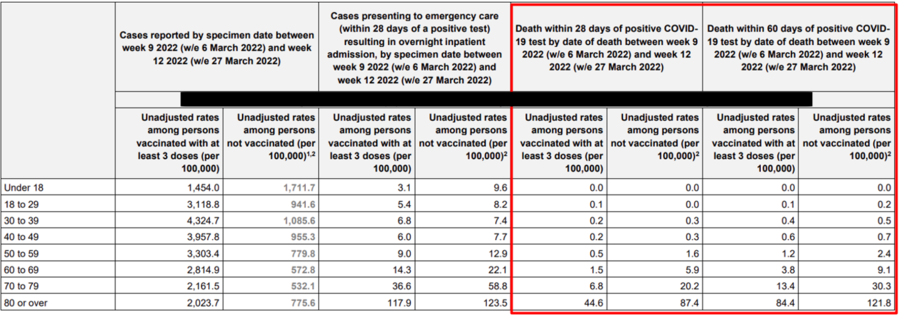
Were COVID-vaccinated young adults 92 percent more likely to die than their unvaccinated counterparts in England during the first full year that the vaccines were available? No, that's not true: While U.K. health agencies report that the figures are generally correct, the numbers were stripped of crucial context about vaccine breakthrough infection and the demographics of those prioritized for vaccination.
The claim appeared in an article (archived here) published by The Exposé on October 26, 2022, under the title "COVID Vaccinated Young Adults are 92% more likely to die than Unvaccinated Young Adults according to UK Government." It opened:
Official figures published by the UK's Office for National Statistics show that deaths per 100,000 among double vaccinated 18-39-year-olds between January 2021 and January 2022 were on average 91% higher than deaths per 100,000 among unvaccinated 18-39-year-olds between January 2021 and January 2022.
This means it can no longer be denied that the Covid-19 vaccines are deadly because even the official Government published figures now prove it.
This is what the post looked like on The Exposé website at the time of writing:
(Source: The Exposé screenshot taken on Mon Oct 31 14:20:28 2022 UTC)
Vaccine availability
While the data show figures for vaccinated and unvaccinated 18- to 39-year-olds between January 2021 and January 2022, very few people in that age group (here and here) could get the COVID vaccine until the second half of the year. Those who could get the shots earlier, starting in February 2021, had underlying health conditions that put them at higher risk of serious disease and mortality.
Alisha Arthur, a media relations officer for the U.K. Office for National Statistics (ONS), told Lead Stories in an October 31, 2022, email that mortality rates should be interpreted carefully for young people because of the way young people at risk were prioritized during the vaccine rollout:
Differences in mortality rates between people who were unvaccinated and vaccinated can be misleading if the two groups differ in characteristics associated with mortality, such as comorbidities. In the UK, the vaccination campaign prioritised elderly people, people who were clinically vulnerable and healthcare workers. As a result, the proportion of people with comorbidities was much higher in young people who were vaccinated than in those who were not vaccinated.
Clinically vulnerable young people have a higher mortality rate than those with no comorbidities, and this explains why vaccinated young people have higher rate of death than those who remained unvaccinated.
Analyzing the numbers
A study, published by the ONS and the U.K. Office of Health Improvement and Disparities, looked at data on COVID vaccination and mortality in young people in an overlapping age group through March 2022. The U.K. Medicines and Healthcare products Regulatory Agency's news center provided its analysis of it in an October 31, 2022, email. It said:
The study found no indication of an increased risk of death from cardiac-related or other causes in those aged 12-29 years, in the six weeks following COVID-19 vaccination. This is consistent with findings from our rigorous safety monitoring activities. The study also suggested that the excess in death registrations in young people in 2021 was due to delays in the registration process and early indications of increased numbers of deaths due to non-vaccine related external causes.
High vaccination rate
A nation's vaccination rate is an important lens when looking at COVID-related deaths. Page 44 of the U.K. Vaccine Surveillance Report (VSR) explains why it matters:
In the context of very high vaccine coverage in the population, even with a highly effective vaccine, it is expected that a large proportion of cases, hospitalisations and deaths would occur in vaccinated individuals, simply because a larger proportion of the population are vaccinated than unvaccinated and no vaccine is 100% effective. This is especially true because vaccination has been prioritised in individuals who are more susceptible or more at risk of severe disease. Individuals in risk groups may also be more at risk of hospitalisation or death due to non-COVID-19 causes, and thus may be hospitalised or die with COVID-19 rather than because of COVID-19.
In England, 76.4 percent of the population is fully vaccinated, according to Our World in Data. Additional details on vaccination in England are available on the country's coronavirus website.
An October 28, 2022, email from the U.K. Health Security Agency explains why more deaths may be reported in people who are vaccinated than unvaccinated. Senior Communications Officer Chris Hewett told Lead Stories why:
It is not because people who are vaccinated are more likely to die, it is because more people are vaccinated than unvaccinated. There will always be some breakthrough infections leading to death because no vaccine is 100% effective, but a small proportion of a very large (vaccinated) population is sometimes bigger than a larger proportion of a smaller (unvaccinated) population.
The important statistic here is the rate of death for each group. Percentage wise, the proportion of deaths remains higher in those who are unvaccinated, compared to those who are vaccinated. ... As you can see [in Table 14 of the VSR below], in every age group (barring in this report the very low numbers in the 18-29 age group under the 'deaths within 28-days' column), the rate of death is higher in those who are unvaccinated, compared to those who are vaccinated with at least three doses.
Table 14:
(Source: Vaccine Surveillance Report screenshot taken on Mon Oct 31 19:06:46 2022 UTC)
Additional Lead Stories fact checks related to COVID-19 vaccines can be found here.
















